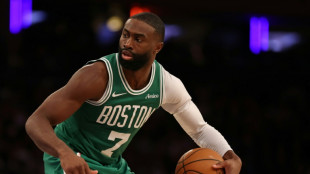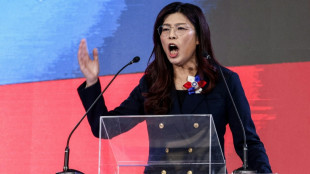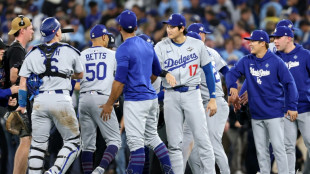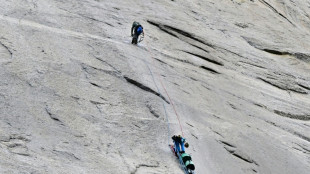
-
 Explorers seek ancient Antarctica ice in climate change study
Explorers seek ancient Antarctica ice in climate change study
-
India's Iyer discharged from hospital after lacerated spleen

-
 Serbia marks first anniversary of deadly train station collapse
Serbia marks first anniversary of deadly train station collapse
-
Latin America weathered Trump tariffs better than feared: regional bank chief

-
 Bangladesh dockers strike over foreign takeover of key port
Bangladesh dockers strike over foreign takeover of key port
-
Tanzania president wins election landslide after deadly protests

-
 Sixers suffer first loss, Bulls stay perfect as NBA Cup opens
Sixers suffer first loss, Bulls stay perfect as NBA Cup opens
-
Dodgers, Blue Jays gear up for winner-take-all World Series game seven

-
 Taiwan's new opposition leader against defence spending hike
Taiwan's new opposition leader against defence spending hike
-
China to exempt some Nexperia chips from export ban

-
 Dodgers hold off Blue Jays 3-1 to force World Series game seven
Dodgers hold off Blue Jays 3-1 to force World Series game seven
-
Crowns, beauty, fried chicken: Korean culture meets diplomacy at APEC

-
 Panama wins canal expansion arbitration against Spanish company
Panama wins canal expansion arbitration against Spanish company
-
Myanmar fireworks festival goers shun politics for tradition

-
 China to exempt some Nexperia orders from export ban
China to exempt some Nexperia orders from export ban
-
Sixers suffer first loss as NBA Cup begins

-
 China's Xi to meet South Korean leader, capping APEC summit
China's Xi to meet South Korean leader, capping APEC summit
-
Japan's Chiba leads after Skate Canada short program

-
 Finland's crackdown on undocumented migrants sparks fear
Finland's crackdown on undocumented migrants sparks fear
-
Climbers test limits at Yosemite, short-staffed by US shutdown

-
 Gstaad gives O'Brien record 21st Breeders' Cup win
Gstaad gives O'Brien record 21st Breeders' Cup win
-
After the tears, anger on Rio's blood-stained streets

-
 Sinner boosts number one bid in Paris, to face Zverev in semis
Sinner boosts number one bid in Paris, to face Zverev in semis
-
Springer back in Toronto lineup as Blue Jays try to close out Dodgers

-
 Nationals make Butera MLB's youngest manager since 1972
Nationals make Butera MLB's youngest manager since 1972
-
Guirassy lifts Dortmund past Augsburg ahead of Man City clash

-
 G7 says it's 'serious' about confronting China's critical mineral dominance
G7 says it's 'serious' about confronting China's critical mineral dominance
-
NFL fines Ravens $100,000 over Jackson injury status report

-
 NBA refs to start using headsets on Saturday
NBA refs to start using headsets on Saturday
-
Trump says Christians in Nigeria face 'existential threat'

-
 French-Turkish actor Tcheky Karyo dies at 72
French-Turkish actor Tcheky Karyo dies at 72
-
Food stamps, the bulwark against hunger for over 40 mn Americans

-
 Trump keeps world guessing with shock nuclear test order
Trump keeps world guessing with shock nuclear test order
-
Wall Street stocks rebound on Amazon, Apple earnings

-
 US Fed official backed rate pause because inflation 'too high'
US Fed official backed rate pause because inflation 'too high'
-
Prayers and anthems: welcome to the Trump-era Kennedy Center

-
 Swiss central bank profits boosted by gold price surge
Swiss central bank profits boosted by gold price surge
-
Sinner beats Shelton to boost number one bid in Paris

-
 French court jails Bulgarians for up to four years for Holocaust memorial defacement
French court jails Bulgarians for up to four years for Holocaust memorial defacement
-
Profits dip at ExxonMobil, Chevron on lower crude prices

-
 Ashraf and Mirza skittle South Africa as Pakistan win 2nd T20
Ashraf and Mirza skittle South Africa as Pakistan win 2nd T20
-
2,000 trucks stuck in Belarus after Lithuania closes border: association

-
 French lawmakers reject wealth tax proposal in budget debate
French lawmakers reject wealth tax proposal in budget debate
-
Premier League blames European expansion for lack of Boxing Day games

-
 Bublik sets up Auger-Aliassime semi-final at Paris Masters
Bublik sets up Auger-Aliassime semi-final at Paris Masters
-
World's most expensive coffee goes on sale in Dubai at $1,000 a cup

-
 Trump stirs global tensions, confusion with nuclear test order
Trump stirs global tensions, confusion with nuclear test order
-
Panic across US as health insurance costs set to surge

-
 Court eases ban on Russian lugers but Olympic hopes on thin ice
Court eases ban on Russian lugers but Olympic hopes on thin ice
-
England captain Itoje targets Autumn Nations clean sweep


Invasive ants hit Texas hard - now a killer fungus is coming for them
When crazy ants roll into new parts of Texas, the invasive species wipe out local insects and lizards, drive away birds, and even blind baby rabbits by spewing acid in their eyes.
Scientists at the University of Texas at Austin now have good news: a naturally occurring fungus-like pathogen can be used to reverse their rampant spread across the southeastern United States, where they have wrought havoc for the past 20 years.
The findings were described Monday in the Proceedings of the National Academy of Sciences.
Ecologist and lead author Edward LeBrun told AFP that the fungus had already driven pockets of the invaders to extinction, and would soon be tested at environmentally-sensitive sites to protect endangered species.
Like fire ants, whom they have displaced in parts of Texas, tawny crazy ants are native to Argentina and Brazil and came to the United States via ships.
They are called "crazy" because of their erratic, jarring movements -- unlike the orderly marches of their cousin species.
While they don't have the venomous bite of fire ants, they secrete formic acid that shields them against fire ant venom, and incapacitates native animals.
"It's kind of a horror show," said LeBrun, who described apocalyptic rivers of ants swarming trees at an infestation site he visited at the Estero Llano Grande State Park, which had lost native ants, insects, scorpions, snakes, lizards and birds to the invaders.
Not only are they destroying ecosystems, "they're miserable to live with" for humans, said LeBrun. The ants seek out electrical systems to nest in, causing shorts in breaker boxes, AC units and sewage pumps.
Pesticides are highly toxic and serve only to slow their progress, leading to snowdrift piles of dead ants that have to be cleared, and the ants eventually break through anyway.
- Trojan ants -
About eight years ago, LeBrun and one of his co-authors Rob Plowes were studying crazy ants they had collected in Florida when they noticed some had unusually large abdomens swollen with fat.
When they looked inside their bodies, the scientists found fungal spores from a microsporidian -- a type of fungal pathogen -- and the species they found was entirely new to science.
Microsporidians commonly hijack an insect's fat cells, turning them into spore factories.
The pathogen's origins aren't clear -- perhaps it came from South America or perhaps from another insect.
Whatever the case, the team found it cropping up across Texas. They observed 15 populations for eight years, finding that every population harboring the pathogen declined, and 60 percent of the populations went completely extinct.
As an experiment, the team decided to place infected ants with uninfected ants at a nesting site inside a state park, placing hot dogs around the exit chambers of a box to entice the two groups to mingle.
The crazy ants form "supercolonies," which means separate groups don't fight each other for territory. This is a great advantage when swarming new areas, but it also turned out to be their biggest weakness, since it allowed the pathogen to spread unchecked.
The test was a huge success, driving the crazy ant population at the state park down to zero within a few years. Larvae that were tended by infected worker ants appeared particularly susceptible.
LeBrun explained this was good news in two ways: first, a pathogen of natural origin was selectively targeting the invasive species, limiting their ability to steamroll local ecosystems.
Second, scientists can accelerate the spread of the pathogen to kill the crazy ants quicker.
He cautioned, however, that the process was labor intensive, not something that could eradicate the species overnight.
The team will continue testing their new biocontrol approach at sensitive Texas habitats this spring.
N.Awad--SF-PST




